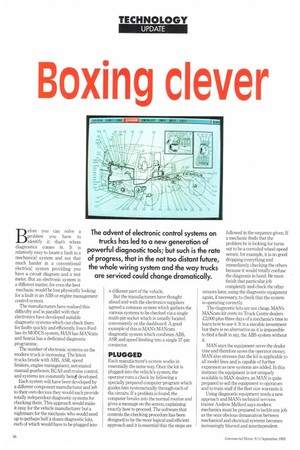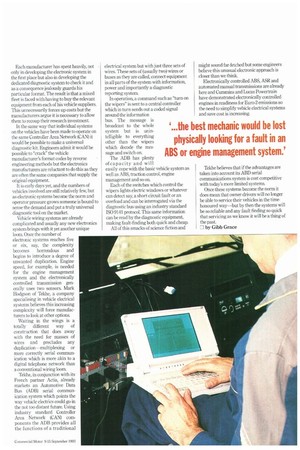Boxing clever
Page 40

Page 41

If you've noticed an error in this article please click here to report it so we can fix it.
Before you can solve a problem you have to identify it: that where diagnostics comes in. It is relatively easy to locate a fault in a mechanical system and not that much harder in a conventional electrical system providing you have a circuit diagram and a test meter. But an electronic system is a different matter, for even the best mechanic would be lost physically looking for a fault in an ABS or engine management control system.
The manufacturers have realised this difficulty and in parallel with their electronics have developed suitable diagnostic systems which can check them for faults quickly and efficiently. Iveco Ford has its MODUS system, MAN has MANcats and Scania has a dedicated diagnostic programme.
The number of electronic systems on the modern truck is increasing. The latest trucks bristle with ABS, ASR, speed limiters, engine management, automated manual gearboxes, ECAS and cruise control; and systems are constantly being developed.
Each system will have been developed by a different component manufacturer and left to their own devices they would each provide totally independent diagnostic systems for checking them. This approach would make it easy for the vehicle manufacturer but a nightmare for the mechanic who would need up to perhaps half a dozen diagnostic kits, each of which would have to be plugged into a different part of the vehicle.
But the manufacturers have thought ahead and with the electronics suppliers agreed a common system which gathers the various systems to be checked via a single multi-pin socket which is usually located conveniently on the dashboard. A good example of this is MAN's MANcats diagnostic system which combines ABS, ASR and speed limiting into a single 37-pin connector.
PLUGGED
Each manufacturer's system works in essentially the same way. Once the kit is plugged into the vehicle's system, the operator runs a check by following a specially prepared computer program which guides him systematically through each of the circuits. If a problem is found, the . computer breaks into the normal routine and gives a message on the screen, explaining exactly how to proceed. The software that controls the checking procedure has been designed to be the most logical and efficient approach and it is essential that the steps are followed in the sequence given. If a mechanic finds that the problem he is looking for turns out to be a corroded wheel-speed sensor, for example, it is no good dropping everything and immediately checking the others because it would totally confuse the diagnosis in hand. He must finish that particular job completely and check the other sensors later, using the diagnostic equipment again, if necessary, to check that the system is operating correctly.
The diagnostic kits are not cheap. MAN's MANcats kit costs its Truck Centre dealers £3,000 plus three days of a mechanic's time to learn how to use it. It is a sizeable investment but there is no alternative as it is impossible to find a fault in say, the ABS system without it.
MAN says the equipment saves the dealer time and therefore saves the operator money. MAN also stresses that the kit is applicable to all model lines and is capable of further expansion as new systems are added. In this instance the equipment is not uniquely available to MAN dealers, as MAN is quite prepared to sell the equipment to operators and to train staff if the fleet size warrants it.
Using diagnostic equipment needs a new approach and MAN's technical services trainer Andrew Mellard says modern mechanics must be prepared to tackle any job as the once obvious demarcation between mechanical and electrical systems becomes increasingly blurred and interdependent. Each manufacturer has spent heavily, not • only in developing the electronic system in the first place but also in developing the dedicated diagnostic system to check it and as a consequence jealously guards his particular format, The result is that a mixed fleet is faced with having to buy the relevant equipment from each of his vehicle suppliers. This unnecessarily forces up costs but the manufacturers argue it is necessary to allow them to recoup their research investment.
In the same way that individual systems on the vehicles have been made to operate on the same Controller Area Network (CAN) it would be possible to make a universal diagnostic kit. Engineers admit it would be possible to "crack" the vehicle manufacturer's format codes by reverse engineering methods but the electronics manufacturers are reluctant to do this as they are often the same companies that supply the original equipment.
It is early days yet, and the numbers of vehicles involved are still relatively few, but as electronic systems become the norm and operator pressure grows someone is bound to sense the demand and put a truly universal diagnostic tool on the market.
Vehicle wiring systems are already complicated and usually any new electronics system brings with it yet another unique loom. Once the number of electronic systems reaches five or six, say; the complexity becomes horrendous and begins to introduce a degree of unwanted duplication. Engine speed, for example, is needed for the engine management system and the electronically controlled transmission generally uses two sensors. Mark Hodgson of Tekhe, a company specialising in vehicle electrical systems believes this increasing complexity will force manufacturers to look at other options.
Waiting in the wings is a totally different way of construction that does away with the need for masses of wires and precludes any duplication multiplexing or more correctly serial communication which is more akin to a digital telephone network than a conventional wiring loom.
Tekhe, in conjunction with its French partner Actia, already markets an Automotive Data Bus (ADB) serial communication system which points the way vehicle electrics could go in the not too distant future. Using industry standard Controller Area Network (CAN) components the ADB provides all the functions of a traditional electrical system but with just three sets of wires. These sets of (usually two) wires or buses as they are called, connect equipment in all parts of the system with information, power and importantly a diagnostic reporting system.
In operation, a command such as "turn on the wipers" is sent to a central controller which in turn sends out a coded signal around the information bus. The message is broadcast to the whole system but is unintelligible to everything other than the wipers which decode the message and switch on.
The ADB has plenty ofcapacity and will easily cope with the basic vehicle system as well as ABS, traction control, engine management and so on_ Each of the switches which control the wipers lights electric windows or whatever can detect say, a short-circuit fault or an overload and can be interrogated via the diagnostic bus using an industry standard ISO 9141 protocol. This same information can be read by the diagnostic equipment, making fault-finding both quick and cheap.
All of this smacks of science fiction and might sound far-fetched but some engineers believe this unusual electronic approach is closer than we think.
Electronically controlled ABS, ASR and automated manual transmissions are already here and Cummins and Lucas Powertrain have demonstrated electronically controlled engines in readiness for Euro-2 emissions so the need to simplify vehicle electrical systems and save cost is increasing.
Tekhe believes that if the advantages are taken into account its ABD serial communications system is cost competitive with today's more limited systems.
Once these systems become the norm it does mean that owner-drivers will no longer be able to service their vehicles in the timehonoured way—but by then the systems will be so reliable and any fault finding so quick that servicing as we know it will be a thing of the past.
II by Gibb Grace


























































































